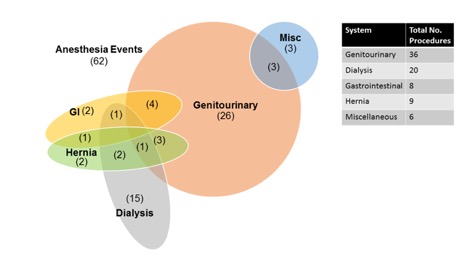Surgical interventions and anesthesia exposure in the first year of life for patients with prenatally diagnosed lower urinary tract obstruction
Rodolfo A. Elizondo, MD1, Kathleen Puttmann, MD1, Jeff White, MD1, Kunj Sheth, MD1, Lily Wang, MD1, Gene O. Huang, MD1, Michael Braun, MD1, David Mann, MD1, Olutoyin Olutoye, MD1, Duong Tu, MD1, Rodrigo Ruano, MD2, Michael Belfort, MD1, Mary Brandt, MD1, David R. Roth, MD1, Chester Koh, MD1.
1Texas Children's Hospital / Baylor College of Medicine, Houston, TX, USA, 2Mayo Clinic, Rochester, MN, USA.
Background: Prenatal diagnosis of lower urinary tract obstruction can lead to prenatal and postnatal interventions to relieve obstruction and to treat sequelae. The recent FDA communication on potential adverse neurocognitive effects of anesthesia in children has raised awareness of the number of postnatal anesthetic encounters associated with LUTO treatment. The primary objective was to quantify the number of surgical interventions and anesthesia events for patients with prenatally diagnosed LUTO. The secondary objective was to evaluate if a prenatal LUTO staging system is predictive of the number of anesthesia events for prenatally diagnosed LUTO patients.METHODS: We reviewed the perinatal clinical records for prenatally diagnosed LUTO patients from 2012-2015. Patients were stratified by prenatal shunt status and by LUTO disease severity according to Ruano et al. USOG, 2016. Statistical modeling was used to assess the relationship of gestational age , birth weight, shunting, and stage with anesthesia encounters.RESULTS: 31 patients were identified and postnatal records were available for 21 patients (seven patients in each stage). When combining prenatal and postnatal anesthesia episodes, there was a significant increase in the number of anesthesia encounters with increasing disease severity 1.6, 3.7, and 6.7 for Stage I, II, and III respectively; Figure 1 and Table 1. Upon univariate analysis, higher GA at birth was associated with a decreased number of anesthesia events in the first year p = .031. Birth weight and GA were inversely associated with number of perinatal anesthesia exposures p=.005 and .038. CONCLUSIONS: Infants with increased prenatal LUTO severity experienced a higher number of perinatal anesthesia events. Higher gestational age and birth weight are associated with fewer perinatal anesthesia events. Future studies will evaluate later outcomes including the neurocognitive outcomes in this population.
| Stage I (n=6) | Stage II (n=5) | Stage III (n=10) | p value | |
| Anesthesia Encounters First Year of Life | 1.43 ± 1.51 | 2.29 ± 1.6 | 5.14 ± 4.22 | .10 |
| Prenatal + Postnatal Anesthesia | 1.57 ± 1.51 | 3.71 ± 2.06 | 6.71 ± 4.82 | .03 |
| Creatinine at 1 year (mg/dL) | 1.13 ± 1.48 | 1.87 ± 2.46 | 2.18 ± 2 | .34 |

Back to 2018 Program




